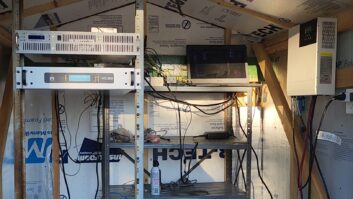WASHINGTON — LPFM broadcasting advocates say new rules forthcoming from the FCC will expand low-power radio opportunities and could bring about a long-awaited filing window before the end of 2011.
Just how many new FM community licensees will be created is not known; some observers expect thousands of applications. However, some experts predict many fewer will get through the settlement and selection process, be constructed and get on the air.

A technician from Wave Communications installs an antenna at WOCT(LP) in 2005. Engineering consultant Benjamin Evans worked with Oshkosh Community Media Services, a division of the city of Oshkosh, to get its low-power station on the air. By the FCC’s count there are now 835 LPFMs, mostly in small communities and rural areas. The new rules guiding low-power broadcasting could open up the possibility of some stations in urban centers like Boston or Chicago, some analysts predict, though others say the barrier to entry into the largest markets remains high.
Steps to implement the “Local Community Radio Act,” which President Obama signed after its passage by Congress in late 2010, are yet to be spelled out by the FCC in revised LPFM rules.
“The commission will take swift action to open the dial to new low-power radio stations and the valuable service they provide,” Chairman Julius Genachowski promised in a statement.
The act requires the commission to conduct an economic survey to study the effects of low-power stations on full-power commercial FMs; that is to be completed by Jan. 4, 2012. The results could affect how the FCC shapes the rules, experts said, and the timeline for introducing them.
An FCC spokesman declined to comment on how quickly the commission would move on the issue.
No more chafing?
The agency created the LPFM service in 2000, authorizing noncommercial educational broadcasting with a maximum of 100 watts or less to cover a service radius of approximately 3.5 miles. LPFM stations function under many of the same operational rules as full-service stations but are not protected from interference from full-power stations.
The service’s supporters long have chafed over strict spacing limitations. The National Association of Broadcasters had opposed suggestions to relax protection against interference to commercial stations. Previous versions of the recent bill failed to gain enough votes until NAB agreed to the easing of third-adjacent — and, in some cases, second-adjacent — protections.
The association said the new rules will serve to reaffirm the primary status of full-power radio stations. “NAB got everything we were seeking in the legislation, which included primary status for full-power stations and spacing rules to protect full-power stations against interference,” said NAB Executive Vice President of Communications Dennis Wharton.
Low-power backers and others said LPFMs had been allocated on the minimum-spacing method, while the new law removes almost all of the restrictions on spacing between LPFMs and third-adjacent-channel stations.
“The law prohibits the FCC from reducing first- and second-adjacent separations, but does allow the commission to grant waivers of second-adjacent spacing when the LPFM applicant can establish that the proposed station will not cause interference,” said Harry Cole, a communications attorney with Fletcher, Heald & Hildreth who also writes for Radio World.
The final FCC interpretation of the law will determine actual spacing requirements, experts agreed.
Consultants and broadcast engineers contacted for this story expect the agency will be bombarded with applications for new low-power service once a filing window is introduced. The FCC first must use the Notice of Proposed Rulemaking process to modify existing rules. It can open an LPFM filing window 30 days after publication of new rules in the Federal Register, observers said.
“I would expect there could be as many as 5,000 to 10,000 filing for new 100-watt low-power service,” said B. Benjamin Evans, president of Evans Engineering Solutions.
“Yet, based on past experience, my estimate is that after competing applications go away, about 25 percent or less of the LPFM applicants that remain would get on the air. The reasons for the low execution rate have mostly to do with the non-profit nature of the service and the lack of broadcast experience of the vast majority of applicants.”
According to the Prometheus Radio Project, which advocates for low-power community radio, 3,259 applications for service were submitted in the original filing window in 2000.
Evans, whose firm is based in Thiensville, Wis., conducted numerous LPFM frequency searches for organizations in the first filing window. He is convinced many groups are “chomping at the bit” to file.
“It’s been 10 years since applications for new LPFM service have been accepted. There is significant pent-up demand for service.”
Translator questions
Prometheus hopes the new rules will open chunks of spectrum in urban areas that have never had access to community radio. However, most observers say the opportunities in major cities like Chicago, San Francisco and Houston are likely to be very limited.
“The demand is there,” said Maggie Avener, technical & training officer for Prometheus. “We received inquiries from over 300 churches, schools and community groups interested in applying for LPFM licenses in the first two weeks after Congress passed the Local Community Radio Act. The greatest interest appears to be concentrated on the Gulf Coast.”
Prometheus, which hasn’t helped build new LPFM stations since 2007, says it is working with the FCC to make sure some open channels in major cities are preserved for LPFM service.
“A lot depends on the resolution of the Auction 83 translator applications from 2003. Thousands of applications were filed, over half by 15 organizations. If too many of those applications are granted, many of the best channels in cities will be given to speculators or networks that repeat canned programming rather than to LPFMs that produce local content,” Avener said.
Prometheus is suggesting the commission open an LPFM licensing window before acting on the pending translator applications, in order to gauge demand in local communities.

Prometheus Radio Project has helped launch low-power stations with ‘barn raisings.’ Its most recent such event was for a full-power FM in New York’s Hudson Valley last September. Volunteers solder audio cables for the WGXC(FM) studio. Meanwhile, 10 radio group owners with a total of 21 pending translator applications from 2003 recently urged the commission to process their translator applications, provided spectrum is available in a community for an LPFM.
Womble Carlyle communications attorney John Garziglia told Radio World these translator applicants want to provide fill-in service or rebroadcast HD2 or signal-deficient AM signals. The group does not include licensees that have built translator networks, such as Educational Media Foundation, which owns and operates the K-Love and Air 1 networks.
Prometheus the LPFM backer and EMF the translator advocate surprised many in the industry last year by submitting a joint memorandum of agreement. They urged the commission to open an LPFM filing window in which low-power broadcasters would receive preference over translators. They also suggested LPFM stations should be authorized to operate on 87.5, 87.7 and 87.9 MHz.
However, the new legislation spells out that full-service FMs are primary services in terms of spectrum priority, while translators, boosters and LPFMs are equal secondary services.
EMF filed supplemental comments in January, stating that the LPFM bill “does not specifically address the disposition of the Auction No. 83 applications,” though it said the act did “dispose of” other issues such as the question of priority. “Thus, the commission must deal with the issue of how to ensure that licenses are available for LPFM stations and FM translators … while still treating the services as equal.”
EMF also wrote that the new law does not preclude the proposals it put forth in its compromise with Prometheus. It did not reply to a request for comment for this story.
‘Prepare’
Now what? Proponents said organizations interested in obtaining LPFM licenses should take steps to prepare for the application window as the FCC navigates its rulemaking process. Prometheus is advising potential applicants to be ready to file by late this year.
Michelle Eyre of REC Networks, a community broadcasting consultant and advocacy group, tells potential LPFM applicants, “At this time, we can not speculate what the new parameters will be or the timeline of the rulemaking process and subsequent filing window. REC’s advice is to prepare. Get your organization established, if it isn’t already.”
Observers said the economy also could play a role in how many low-power suitors will be interested once a filing window is established. “If the economy doesn’t improve appreciably, I would not expect a flood of apps. If the filing window were open today I would guess there would be a thousand or so applications,” said Jon Kenneke, president of Kenneke Communications LLC.
His firm in Albany, Ore., provides services ranging from license application searches to studio maintenance. He said the low-power stations he has worked with have impressed him with their financial know-how.
“These LPFM broadcasters have introduced me to a novel way to raise and save money. I’ve been impressed with what they can do on a very small budget.” Kenneke predicts the FCC won’t open a new window until late 2012.
However, John Broomall, president of Christian Community Broadcasters, also an advocacy and broadcast consulting firm, said he expects the FCC to announce the rules process and open an LPFM filing window before the end of 2011.
“There will be some opportunities for urban stations. However, I expect the vast majority will be allocated to the suburbs and small cities.”











